SCREEN
COLORS Lets you select colors for chart and
oscilloscope screens from the standard Mac color wheel. Obviously,
this option is not available on monochrome monitors. Color preferences
can be saved for automatic re-use the next time the program is launched
(use the SAVE PREFERENCES menu selection). This option is deselected
unless color is in use.
 TIME GRIDS submenu
These submenus control the display of
vertical (time) grid lines: TIME GRIDS submenu
These submenus control the display of
vertical (time) grid lines:
SHOW
TIME GRID Activates or deactivates the display
of time grids and tics in plot areas during data acquisition.
DASHED
GRID LINES Toggles between dashed and solid
grid lines in plot areas. NOTE: this option is deselected unless
SHOW TIME GRIDS is 'on'.
DASHED
MARKER LINES Toggles between normal (dashed)
and solid marker lines in plot areas. During chart file acquisition,
markers appear when individual keys are pressed.
 SCALE GRIDS submenu
These submenus control the display of
horizontal (scale) grid lines: SCALE GRIDS submenu
These submenus control the display of
horizontal (scale) grid lines:
SHOW
SCALE GRID Activates or deactivates the display
of time grids and tics in plot areas during data acquisition.
MANY
GRID LINES Toggles between normal and high-density
grid lines in plot areas. NOTE: this option is deselected unless
SHOW TIME GRIDS is 'on'.
SHOW
ZERO LINES Toggles between visible and hidden
zero lines in plot areas. These indicate the position of zero, if
the data range includes zero.
 WINDOW SIZE On
a large screen, these submenus allows use of several window sizes: WINDOW SIZE On
a large screen, these submenus allows use of several window sizes:
SET
WINDOW AREA This option (only available if
the screen is bigger than 640 X 480 pixels -- as is true in all modern
computers) lets you set the display window size by dragging a window to
the desired shape. It will not allow a display size smaller than 640 X
480 pixels, and the window is always in the upper left corner of the screen.
640
X 480, 800 X 600, 832 X 624, 1024 X 768 Sets
the display window size to a specified number of pixels, in the upper left
corner of the screen.
FILL
SCREEN Sets the display window size to fill
the available screen area (no part of the desktop is visible when gathering
data).
PLOT
HEIGHT (not accessible in Multichannel Oscilloscope
mode) allows you to divide the screen up among the different channels
according to your own preferences. For example, you can show some
channels in large vertical scale and others in much smaller scale.
Note that because there is a fixed amount of screen space available, making
a channel larger than normal requires shrinkage of other channels:
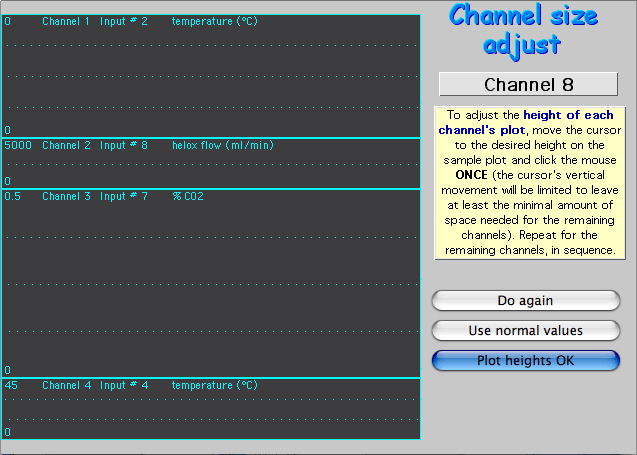
To set channel heights, move the cursor within the simulated plot area
until it is at the desired height, then click. The program steps through
the channels in sequence. When all channels are complete, you can
accept the results, use normal values (all channels with equal heights),
or redo the selection. The program always reserves a minimum amount
of space for any remaining channels (20 pixels high). Channel heights
do not affect other aspects of the data acquisition process.
CHART
VIEWS AND TICS...  G opens a window that allows
selection of the 'density' of data plotted in chart mode: G opens a window that allows
selection of the 'density' of data plotted in chart mode:
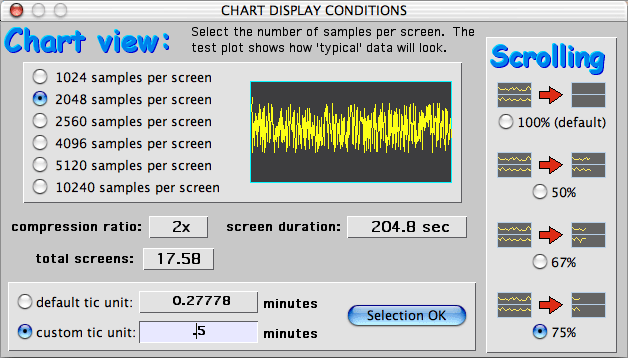
The normal view contains one sample per pixel on the x-axis. However,
you can select compression ratios of 2, 2.5, 4, 5, and 10 (these options
are available only if the number of chart samples is greater than the number
of samples per screen). Thus with a 640-pixel-wide screen, up to 6400
samples can be shown on a single screen. The range is 832 - 8320
when using an 832 pixel-wide screen, and so forth with larger screen sizes.
Using the more compressed views increases the amount of recording time
that fits on the screen, but at the same time the screen resolution is decreased
(for viewing only; not recording) because several samples are plotted within
the same x-axis pixel position.
Some combinations of view compression and maximum sample number may generate
fractional time units on the X-axis of the chart display. However,
you can manually adjust the scaling of the 'time tics' on the x-axis (if
they are used) with the 'use custom tic unit' button (this is automatically
selected if you click in the adjacent edit field).
If the number of samples is greater than can be shown on a single screen,
the chart display must be scrolled when the data plot reaches the
screen's right edge. The default scrolling value is 100% -- that is,
the entire screen is redrawn, showing none of the previously-acquired data.
Alternately you may select fractional scrolling (50%, 67%, or 75%), which
leaves some of the previously-acquired data in view.
SCOPE
VIEWS AND TICS... opens a window that allows
selection of the 'density' of data plotted in chart mode. It is similar
to Chart view, except that it offers options to show only a fraction
of the gathered data (all will be saved if a file is stored). This
can greatly increase the display rate (and hence the fraction of total time
spent in sampling data). Note that you should use the "show
every point" option UNLESS in discontinuous or multichannel oscilloscope
mode:
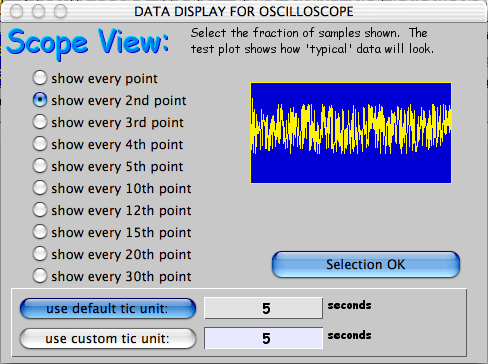
STATUS
DISPLAYS At moderate sampling rates, LabHelper
provides several status displays on the data acquisition screen. These
include the 'data bar' at the top of the screen (showing sample number,
percent completion, time-to-go, etc.), a numeric readout in each
channel, and alarm or device switching status (if selected
by the user). Unfortunately, it takes time to update these displays,
which can slow data acquisition at very high sampling rates. Switching
off the status displays will speed up acquisition, particularly at the fastest
sample rates. Since both updating and sampling speeds are highly
dependent on the speed of the particular CPU and screen, it is something
of a trial and error process to find sampling rates that are compatible
with status displays.
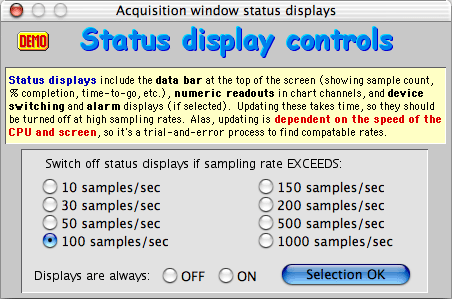
Use this window to adjust the 'cutoff' sampling rate above which status
displays are switched off (you can also instruct LabHelper to leave
them on or off at all speeds).
SHOW
SWITCH STATUS Activates or deactivates a display
of the external device control status during data acquisition. This
shows whether a particular channel's device is acquiring sample data, reference
data, or is inactivated (zeroed).
In addition
to the graphical display, LabHelper shows digital readouts of channel
values during data acquisition. The LARGE READOUTS option toggles
between the normal size digital readout displays (in 10-point type) and
a much larger display (in 20-point boldface) that is more easily visible
from a distance. Note that if you have selected a very small plot
height for a particular channel, a large-format digital readout may not
fit.
SLOPE
TRENDS Opens a window containing controls for
the display of recent trends in the data (positive or negative slope) for
any channel:
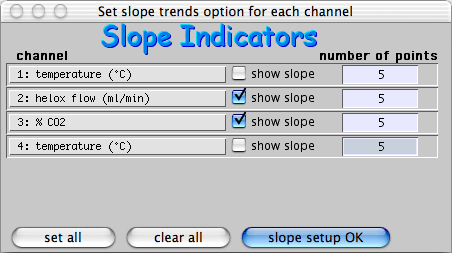
The number of points used to generate the slope trend is user-selectable;
the default value is 5. Slope trends are shown as a "+"
or "-" indicator in the digital display for each channel selected.
NOTE: slope trends is only available in CHART mode, and it does not store
in a 'Setup' file.
ALWAYS
SHOW HELP DATA When this option is checked,
the 'help' data for various windows and operations (normally selected with
the '?' button) will be shown by default.
SIGNIFICANT DIGITS Lets you select the number of significant digits in numeric displays (this has no effect on the precision of recorded data).
Top of page
|
 TIME GRIDS submenu
These submenus control the display of
vertical (time) grid lines:
TIME GRIDS submenu
These submenus control the display of
vertical (time) grid lines:
 SCALE GRIDS submenu
These submenus control the display of
horizontal (scale) grid lines:
SCALE GRIDS submenu
These submenus control the display of
horizontal (scale) grid lines:
 WINDOW SIZE On
a large screen, these submenus allows use of several window sizes:
WINDOW SIZE On
a large screen, these submenus allows use of several window sizes:
 G opens a window that allows
selection of the 'density' of data plotted in chart mode:
G opens a window that allows
selection of the 'density' of data plotted in chart mode: